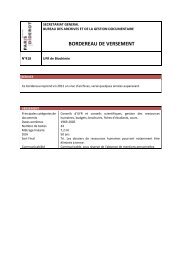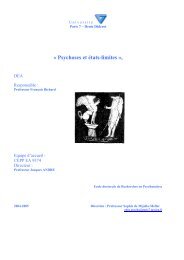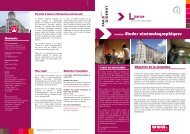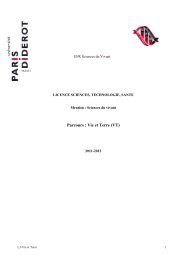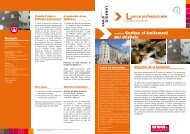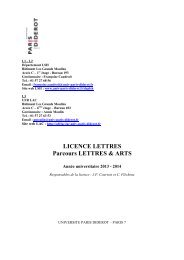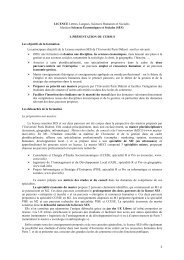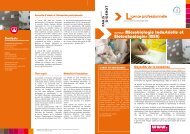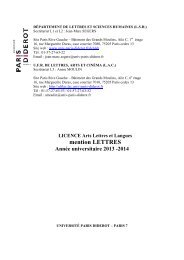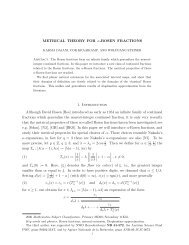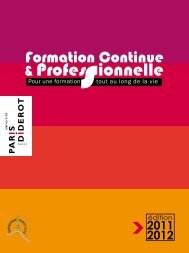Coordinator's names Carole DELPORTE-GALLET Hugues ...
Coordinator's names Carole DELPORTE-GALLET Hugues ...
Coordinator's names Carole DELPORTE-GALLET Hugues ...
Create successful ePaper yourself
Turn your PDF publications into a flip-book with our unique Google optimized e-Paper software.
2 Context, Positionning and Objectives of the proposal<br />
2.1 Context of the proposal<br />
The distributed community can be viewed as the union of two sub-communities. Even though they are not<br />
completely disjoint, they are disjoint enough not to leverage each other’s results. At a high level, one is mostly<br />
interested in timing issues (clock drifts, link delays, crashes, etc.) while the other one is mostly interested in<br />
spatial issues (network structure, memory requirements, etc.). Indeed, one sub-community is mostly focusing<br />
on the combined impact of asynchronism and faults on distributed computation, while the other addresses<br />
the impact of network structural properties on distributed computation. Both communities address various<br />
forms of computational complexities, through the analysis of different concepts. This includes, e.g., failure<br />
detectors and wait-free hierarchy for the former community, and compact labeling schemes and computing<br />
with advice for the latter community.<br />
We illustrate these points by some examples below.<br />
In the wait-free model, each process starts with a private input value, and decides irrevocably a private<br />
output value after a finite number of steps. The processes communicate with each other through shared<br />
objects, but the output decision of each process must occur independently of the speed or actions of other<br />
processes. The output value decided by each process, which must satisfy some input-output specification,<br />
could however depend on the actions of the other processes. A wait-free distributed algorithm performs<br />
correctly in any asynchronous environment, and, in particular, it tolerates an arbitrary number of process<br />
crashes. In this way, the wait-free model may be considered as a special case of t-resiliency for t equal to the<br />
number of processes. Some simulations, like in [4, 5] and general results prove that t-resiliency may generally<br />
be reduced to the wait-free model.<br />
Not all tasks (specified by input-output relations) are wait-free solvable. More specifically, the famous<br />
FLP Theorem [16] states that consensus is not 1-resilient and then not wait-free solvable. Several research<br />
frameworks in the context of wait-free and more generally fault-tolerant computing offer similarities with<br />
computing with oracle machines. One typical example is provided by the failure detector theory [8] which<br />
is based on oracles providing nodes with limited information about the failures. Failure detectors may be<br />
compared by reduction [7]. Hence if every failure detector enabling to solve task A may be reduced to a<br />
failure detector enabling to solve task B, then task A is harder (i.e. needs mode information about failure)<br />
than task B. In this way, failure detectors enable to define hierarchy among unsolvable tasks [10].<br />
Another example is provided by the wait-free hierarchy (including Herlihy’s hierarchy [22]) which maps<br />
object to positive levels such that an object is at level n if and only if it offers some form of universality for<br />
a system of n processes in the wait-free model.<br />
In network computing, networks are modeled by graphs G = (V ; E), in which messages are exchanged<br />
between the processes (i.e., the nodes in V ), along the links of the network (i.e., the edges in E). The model<br />
LOCAL [27] assumes that the nodes operate in synchronous rounds, where a round enables to exchange a<br />
message of arbitrarily large size between every pair of nodes linked by an edge. Hence, in the LOCAL model,<br />
the main measure of interest is the maximum distance at which processes interact. A task (e.g., coloring the<br />
nodes of properly with at most ∆+1 colors) is local if and only if it has an algorithm solving it in O(1) rounds<br />
in the LOCAL model 1 . Not all problems are local. In particular, Linial [25] proved that graph coloring is not<br />
local, even in rings (O(log n) rounds are required to 3-color the ring). Naor and Stockmeyer [26] studied the<br />
class LCL of locally checkable labeling problems. As in the case of wait-free computation, several research<br />
frameworks in the context of local computing offer similarities with computing with oracle machines. One<br />
typical example is distributed computing with advice, which is aiming at capturing the impact of global<br />
structural knowledge (e.g., the size of the network) on the efficiency of solving distributing computing tasks<br />
(like coloring or broadcasting). Another example is proof labeling schemes [24], which is aiming at providing<br />
each node with labels such that the consistency of distributed data-structures (e.g., MST, spanning tree,<br />
etc.) can be checked in one round, just by exchanging labels between neighbors.<br />
1 An interesting restriction do the LOCAL model is the CON GEST (B) model in which the size of exchanged messages is<br />
bounded by B.<br />
4



